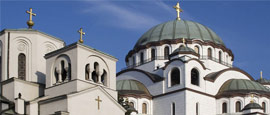The House of Flowers is the tomb of Josip Broz Tito, who was president of Yugoslavia from 1953 until his death in 1980. Under Tito's rule, Yugoslavia distanced itself from Stalin's Russia and followed a non-aligned version of socialism. To this day, Tito is still venerated by many. Although there is not much in the way of information about his life, there is a display of his office furniture and a larger museum showcasing the many state gifts he received. The knowledgeable staff make up for the lack of actual exhibitions with anecdotes and stories.
Things to see in Belgrade
Tourist offices
Opening Hours:
Mon-Sun 0900-1900.
www.tob.rsThis is the main Belgrade Tourist Organisation office. There are a number of offices and information centres dotted around the city, with an office at the airport and the main railway station.
Occupying a wonderful hilltop location, overlooking the confluence of the Sava and Danube Rivers, Kalemegdan Park is a fantastic leafy outdoor space set within the walls of the Belgrade Fortress, which dates back to the Romans. The well-preserved castle is free to walk through and the surrounding park is especially appealing at sunset.
Located in a grand, Republic Square palace from 1844, this is Serbia oldest and biggest museum with nearly half a million items on display. It has everything from Ancient Greek and Roman artefacts to medieval objects which include manuscripts and icons. It is also home to an extraordinary collection of paintings from around the world, including works from Serbian and Hungarian artists.
This fascinating museum has plenty of hands-on displays and is dedicated to the life and work of eccentric Serbian physicist and inventor, Nikola Tesla. Tesla, who worked with Edison in the USA, never quite achieved the fame that he deserved despite inventing AC current and many electrical gadgets and devices.
Often compared to the Montmartre quarter in Paris, Belgrade's old bohemian quarter dates back to the late 19th century when its kafane (taverns and restaurants) were a meeting place for many of the greatest figures in Belgrade's cultural scene. Many famous writers, actors, painters and journalists once lived in Skadarlija, including the famous poet and painter Dura Jakšić. Today the old bohemian quarter is dotted with lively cafés, restaurants, galleries, antique shops and souvenir stalls.
Open only by appointment (weekends from 1 April to 30 October), the palaces of the Royal Compound are the official residences of the Serbian Royal Family and offer a fascinating insight into stately life. Visitors can take a guided tour around The Royal Palace, The White Palace and park of The Royal Compound on the site at leafy Dedinje Hill. Tours must be arranged through the Belgrade Tourist Organisation office at Makedonska 5.
The imposing dome of St Sava's Temple stands at over 70m (230ft) high and can be seen from most locations throughout Belgrade. Began in 1935, it was finally completed in 2004. Dedicated to St Sava, founder of the Serbian Orthodox Church, the temple is built on the site that where his holy relics were believed to be burnt by the Ottoman ruler, Sinan Pasha, at the end of the 16th century.
Formerly a separate town but now a suburb of Belgrade, Zemun occupies a wonderful position north of New Belgrade that overlooks the Danube River. It's actually much older than Belgrade with parts of it dating back to the 3rd century. A relaxing haven from the hustle and bustle of the city centre, Zemun’s Danube riverbank here has numerous bars and cafés and some exceptional fish restaurants.
Football is a huge passion in Belgrade with supporters divided into the two camps of Red Star Belgrade and Partisan Belgrade. Rivalry is fierce between these two teams and derby day games can be fiery affairs. There is a free museum at the Red Star stadium, which is full of football memorabilia including photographs and autographs from the 'Busby Babes' - the legendary Manchester United team who played their last game here against Red Star before their plane tragically crashed.
Founded in 1950, this singular museum celebrates different forms of functional art, particularly of the Serbian variety. There are more than 30,000 artefacts displayed here, from coins of the Ancient Greeks in the 4th century BC, to old manuscripts, painted icons and ceramics. It also houses a number of fascinating temporary exhibitions.
Do you have any Feedback about this page?
© 2025 Columbus Travel Media Ltd. All rights reserved. No part of this site may be reproduced without our written permission, click here for information on Columbus Content Solutions.








 You know where
You know where